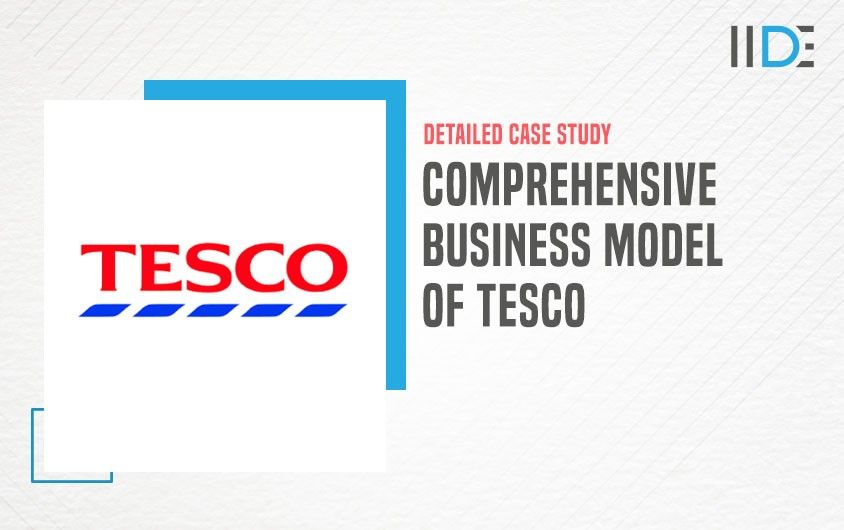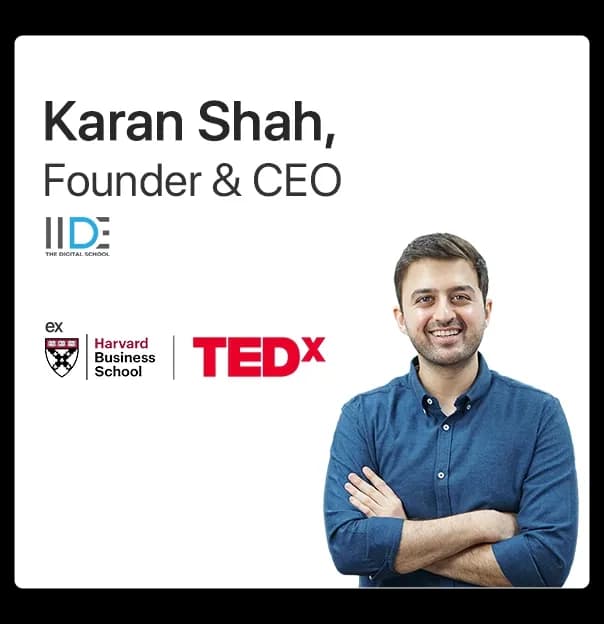
Updated on Aug 9, 2025
Share on:
Tesco is the leading brand in the grocery market with a market share of 27% as of May 2021. it is a famous supermarket chain that is one of the world’s largest retailers that currently operates in 11 different countries, It has a large dominance in the market with its successful business model and strategies. Thus this makes us keen to know the business model of Tesco.
With the high degree of competition in the retail chain industry, marketing your brand to the right customers is a necessity. Digital marketing is the newest venue of promotion and is highly in demand as a skill! If this interests you, then you definitely check out the Free MasterClass on Digital Marketing 101 by the CEO and Founder of IIDE, Karan Shah.
In this blog, we will be looking at the in-depth business model of Tesco and also other related factors. Before we start with its business model let us know about Tesco as a company.
About Tesco
Tesco is a global British grocery and general products company based in Welwyn Garden City, England. It is the world’s third-largest retailer in terms of gross revenues and the ninth-largest in terms of net revenues.
It operates in seven countries across Europe, the United States, and Asia. The company is the grocery market leader in Ireland, Hungary, Thailand, and the United Kingdom.
Tesco is one of the most well-known retail brands in the United Kingdom, particularly when it comes to food shopping. However, you may be surprised to learn that the company also works with other shops such as convenience stores and general merchandise. Since its inception, the British conglomerate has built a reputation for itself through organic expansion and, most notably, a succession of smart acquisitions and subsidiaries.
Tesco’s business has grown through a combination of new store purchases, retail services, and adapting to consumer needs. Tesco’s principal goal is to provide excellent customer service. It’s crucial to keep existing clients happy because they’re more inclined to return. This is less expensive for the company than hiring new employees.
Let us now see the business model of Tesco.
Dynamic Business Model of Tesco
A business model helps in finding the best strategy to use for its business. There are many different business models which the company can choose from. It helps the company to know what the cost of the operation is going to be and the product market where they are going to sell.
The business model of Tesco focuses on four basic actions in order to obtain an understanding of what customers want and need. As a result, the corporation is able to sell and distribute to its clients.
Customers’ shopping experiences will be better and more enjoyable if the company adjusts and improves on their four key activities each time they purchase with them. The following are the four main components of the business model:
Let us now start the learning process by looking at the product segmentation of the company.
Product Segmentation of Tesco
It provides its customers with different types of products under one roof so that it is convenient for its customers to get all things from one place and they don’t go to another retailer. They differentiate themselves by providing more convenient customer services than other large retail chains. They serve mostly the 30+ year-old segment as they provide bulk retail shopping for household owners.
Market Share of Tesco
The coronavirus disrupted and lead to a lot of changes in the retail superstore industry. With closing small groceries, many retailers increased their market share while some lost heavily.
On the other hand, Tesco had the biggest market share increase during the time period studied, accounting for 42.3 per cent of the market as of May 2021. Tesco along with Sainsbury’s, Asda, and Morrisons dominated the grocery retail sector prior to the advent of e-commerce and discounters.
Marketing Channels of Tesco
Tesco works with a variety of channels to provide the best items to its customers, including small shops, large stores, and their growing online business channels. They are investing in making their channels even more efficient and convenient for our consumers as part of upgrading our offer. Ecommerce has taken over the world and become extremely important for both corporations and professionals to be well versed in. To learn more about e-commerce check out IIDE’s Ecommerce Management Course.
Revenue Sources of Tesco
Tesco’s main revenue stream comes from retailing and grocery production. Using big data, Tesco determined which products were being sold the best and started producing their own line of products to increase their profit margins. In order to become even more cost-effective and to allow for more specialization, Tesco followed a vertical expansion strategy.
Tesco, a self-producing corporation, has also had a lot of success because it has been making its own supermarket products for a long time. As a result, it may work at far lower rates than its competitors who do not have the resources to manufacture their own products. The corporation has proven so successful at self-producing its items that it is now involved in the production of high-end products that are offered under the Tesco brand name.
Apart from its production and retailing, they have an e-commerce vertical as well, putting the business model of Tesco apart from its competitors.
Online Store of Tesco
Tesco has been selling its items online with great success in the UK and throughout Europe since the 1980s. Many people are unaware that this creates a unique scenario, as Tesco is the only chain of its kind in Europe that has been able to maintain a viable and profitable online shopping system. This is a classic scenario of weak marketing efforts that lead to overlooking of amazing services that the company maintained.
Store Diversification of Tesco
Tesco has recently begun to vary its store locations in order to make its products more accessible to a wider audience. This way, one does not need to travel out of town to shop at a Tesco; instead, one can stop by a Tesco Express or a Tesco Metro, which were designed specifically for this purpose.


Learn Digital Marketing for FREE


Conclusion
In the business model of Tesco, we have seen that it has organized its business model with the best strategies. It has been providing its customers with many different products in one place and with convenience. It is one of the market leaders with the 3rd position in the market. Making it one of the best grocery store chains in the world. The company has made many smart moves such as starting their own production lines for high demand products and starting their online stores.
The glaring gap in the business model of Tesco is of not relying well on their marketing wing, as demonstrated by the lack of knowledge of their ecommecre store. Learning digital marketing has become a necessity and if upskilling interests you, check out IIDE’s 3 Month Advanced Online Digital Marketing Course to know more.
If you like such in-depth analysis of companies, find more such insightful case studies on our IIDE Knowledge portal.
Hope you liked this case study and found it informative and insightful! Do share your thoughts about the case study in the comments below.
Want to Know Why 2,50,000+ Students Trust Us?
Dive into the numbers that make us the #1 choice for career success

MBA - Level
Post Graduate in Digital Marketing & Strategy
Best For
Fresh Graduates
Mode of Learning
On Campus (Mumbai & Delhi)
Starts from
Jan 5, 2026
Duration
11 Months
Live & Online
Advanced Online Digital Marketing Course
Best For
Working Professionals
Mode of Learning
Online
Starts from
Dec 19, 2025
Duration
4-6 Months

Online
Professional Certification in AI Strategy
Best For
AI Enthusiasts
Mode of Learning
Online
Duration
5 Months

Offline
Undergraduate Program in Digital Business & Entrepreneurship
Best For
12th Passouts
Mode of Learning
On Campus (Mumbai)
Duration
3 Years
Recent Post
Aditya Shastri leads the Business Development segment at IIDE and is a seasoned Content Marketing expert. With over a decade of experience, Aditya has trained more than 20,000 students and professionals in digital marketing, collaborating with prestigious institutions and corporations such as Jet Airways, Godrej Professionals, Pfizer, Mahindra Group, Publicis Worldwide, and many others. His ability to simplify complex marketing concepts, combined with his engaging teaching style, has earned him widespread admiration from students and professionals alike.
Aditya has spearheaded IIDE’s B2B growth, forging partnerships with over 40 higher education institutions across India to upskill students in digital marketing and business skills. As a visiting faculty member at top institutions like IIT Bhilai, Mithibai College, Amity University, and SRCC, he continues to influence the next generation of marketers.
Apart from his marketing expertise, Aditya is also a spiritual speaker, often traveling internationally to share insights on spirituality. His unique blend of digital marketing proficiency and spiritual wisdom makes him a highly respected figure in both fields.